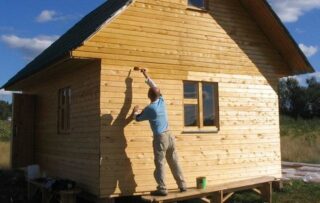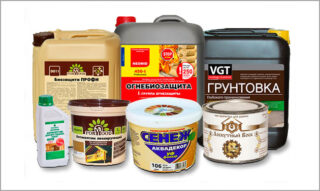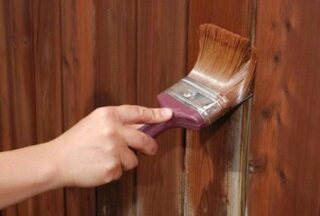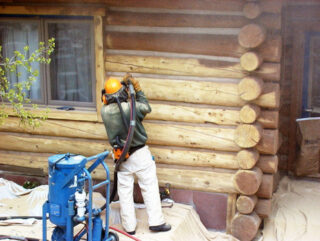A house made of high quality wood is attractive and indicates the high status of its owner. In order for a tree to remain beautiful for a long time, it must be properly treated with protective agents.
The need to process external walls

A wooden house is an environmentally friendly housing, being in which a person experiences only positive emotions. This is due to the fact that wood, with the right attitude to it, is able to provide:
- comfortable microclimate;
- positively charged energy;
- optimum air humidity.
However, all the qualities of wood can be nullified if you do not take into account that this material is characterized by increased moisture absorption. Due to sudden changes in temperature and humidity, wood can:
- to swell;
- dry out;
- crack
- rot.
Ultimately, all these processes lead to a deterioration in the appearance and destruction of the structure.
All kinds of microorganisms, for example, fungus, also have a harmful effect on wood. Untreated walls of a wooden house begin to become stained and moldy.
Wooden surfaces affected by white house fungus are destroyed in a very short time.
One of the main enemies of wood is fire. If a wooden house catches fire, it is almost impossible to save it.
Protecting a wooden house from all sorts of destructive factors is the main task of the owner.
Varieties of wood processing products

A wooden house is protected by various means. Their range is impressive in its variety and is able to satisfy any, even the most stringent requirements that homeowners have.
Types of protective equipment:
- antiseptics;
- fire retardants;
- preservatives;
- protective and finishing agents.
It is not recommended to use combined means that, as written in the instructions, can protect the house from the outside at the same time from rotting, insects, fire, etc.
Antiseptics, absorbed into the wood, help to increase its resistance to moisture and microbes. Among them, the most effective are wax, antiseptic primer, special protective varnish and a variety of oils.
The use of fire retardants allows you to protect a wooden house from open fire for several hours in the event of a fire. The substances that make up the fire retardants, when the temperature rises, form a fire retardant film on logs, beams and other wooden parts of the house that prevents instant ignition.
Preservative impregnations and solutions help to keep the wood in its original condition. Special impregnations prevent the formation of cracks, and water-repellent compounds counteract the effects of moisture on wooden walls of houses.
To preserve and restore the decorative qualities of wooden houses, there are special protective and finishing agents, which include all kinds of varnishes and paints for wood. With their help, wooden surfaces are protected from fading. The range of these materials also includes bleaching compounds that protect the wood from darkening.
Selection recommendations

The treatment of logs inside and outside the home is aimed at protecting against many different factors. At the same time, there is not a single protective agent that could simultaneously protect a wooden structure from all negative influences.
There are general rules for choosing a really effective material that protects a wooden house:
- The service life of any protective coating is from 2 to 5 years. If such a period is indicated on the package, the manufacturer is most likely not lying. If a period of 20-40 years is indicated, most likely it is written somewhere in small print that such a period of validity of the product is possible when this product is applied industrially.
- The consumption of a protective agent is important when choosing a grade of material. It often happens that increased material consumption negates the economic effect of low cost. The optimal consumption of any protective agent (except fire retardant) is 200-250 g / m².
- You should not chase universal drugs, the manufacturers of which promise combined protection against various negative influences. Experts say that the individual substances that make up such funds do not enhance each other's action, but, on the contrary, worsen them.
- When purchasing a protective product, ask for a certificate of conformity, which confirms the safety of the material during application and operation.
The protection of a wooden house should be regularly carried out throughout the entire period of operation.
Wooden house processing rules
Processing of a wooden house from the outside begins directly during its construction, since logs and boards are stored, as a rule, in the fresh air. At this time, they especially need protection.
Do not store the tree on the ground, no matter how well it is treated. Place it on special supports to keep the wood from touching the ground. By doing so, you will protect the materials from the penetration of excessive moisture and prevent damage to it by mold and mildew.
House base treatment
As a rule, a waterproofing pad is laid between the foundation and the frame of the house. However, after 2-3 years, the homeowner notices that a gap appears between them. To avoid this, it is recommended to treat the logs in contact with the foundation with a special wood sealant.
Processing a wooden house outside

The treatment of the house with protective compounds is preceded by the preparation of the walls, which includes:
- grinding surfaces with sandpaper;
- removal of tar stains with a special solution;
- filling cracks and other defects with putty.
The log house outside is treated in two stages: first with a water-based antiseptic, and then with a fire retardant. Only then can a protective finishing agent be applied to the walls.
The greatest danger to the wooden walls of the house is dampness, which contributes to the appearance of mold and the growth of fungus. Therefore, first of all, a wooden house is treated with a deep processing antiseptic that penetrates into the wood and protects it from dampness and the appearance of microorganisms. The end cuts of the logs are processed most carefully, since moisture penetrates through them. Antiseptics are allowed time to dry.
After about 15 days, they begin to process the outer walls of the house with a fire retardant. Fire retardant impregnation forms a film on the wall surface that protects the wood from fire. Such impregnation is applied in 3-4 layers, which makes it more effective.
After the impregnation has dried, they begin to apply protective finishing agents. These include:
- acrylate paints;
- oil paints;
- varnishes that preserve the natural structure of the tree.
Also use:
- special antiseptic materials, among which there are covering (hiding the natural structure of the tree), and glazing (emphasizing the natural shade of the wood);
- mineral, acrylic or mosaic plaster, which is applied to a special frame and mesh, which guarantee the durability of the applied solution.
Facing the walls of a wooden house from the outside with brick or siding is impractical, since various parasites quickly start in the remaining voids.









And where are the oil impregnations for wood?
I covered the house with patchwork wax, which looks like remrs, but more environmentally friendly. For 2 years already, after the rain, water drops on the wood until it dries up.